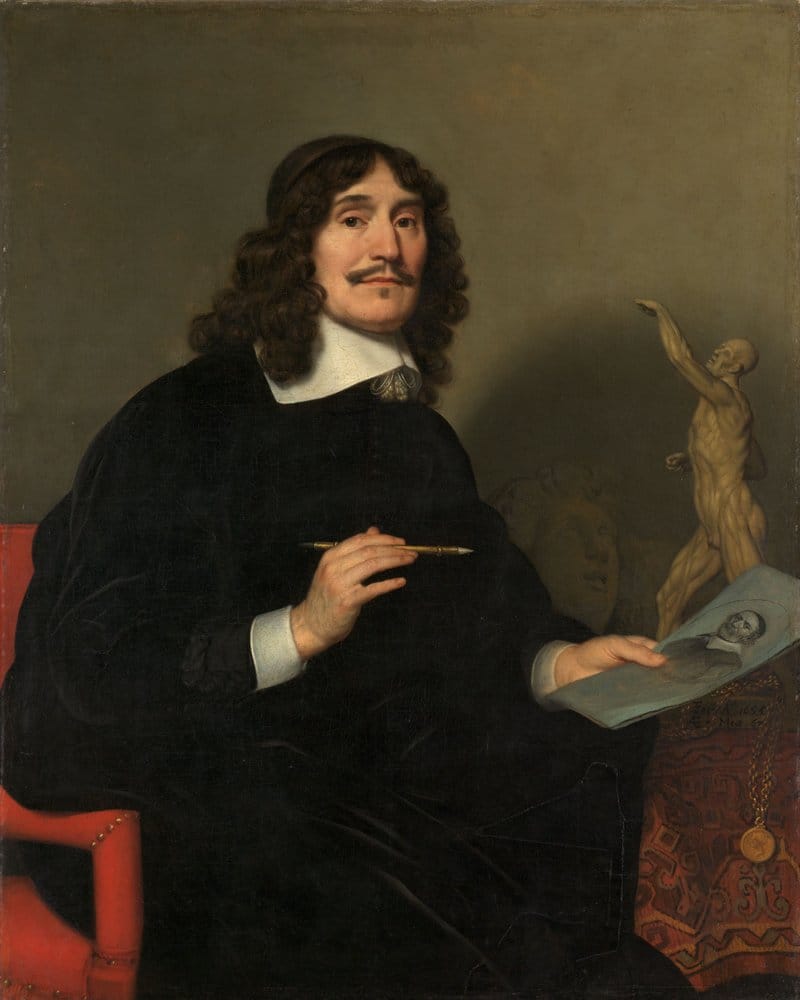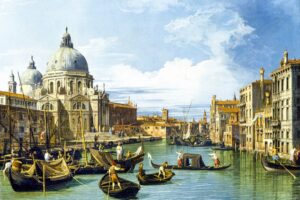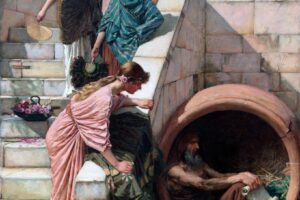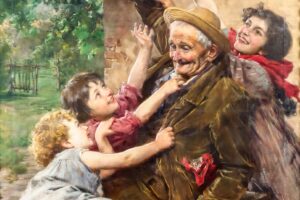The Concert – Gerrit van Honthorst 1625
A joyful harmony floats through the air, laughter mingles with melodies, and time gently pauses, suspended in celebration. In The Concert, Gerrit van Honthorst masterfully captures the cheerful intimacy and vibrant energy of a musical gathering. While the painting is a nocturnal scene, it is bright, rich palette and an affectionate eye for human warmth, this artwork invites us to share in a lively moment of communal joy and connection.
The Scene Before Us
Around a richly decorated table, a colorful group gathers, instruments poised, voices lifted in song. At the heart of the painting is a young woman gently strumming her lute, eyes cast downward in focused serenity. Beside her, another woman, wearing a vibrant blue gown and feathered hat, gracefully plays her lute with passionate elegance. To their side, a young man in a striped outfit adds to the rhythm, immersed in his performance.
The ensemble is guided by a conductor in rich red and black attire, his back to the viewer, directing the scene with gentle authority. His gestures convey both leadership and participation, suggesting harmony is achieved not by dominance but through collaborative grace.
In the background, additional figures celebrate the moment. A young man raises a glass cheerfully, another whispers playfully, adding a touch of humor and intimacy to the scene. The setting is simple yet evocative, allowing the vivid personalities and the richness of the moment to take center stage.
The Deeper Meaning
Honthorst’s painting warmly celebrates music as a universal language, uniting diverse individuals through shared joy and creative expression. Each figure contributes uniquely to the harmony, underscoring the beauty of collective creativity and cooperation. The painting gently reminds us of the powerful connection forged through communal experiences, music being perhaps the most profound among them.
But beyond mere celebration, Gerrit van Honthorst subtly emphasizes human warmth and companionship. The smiles exchanged, the gentle glances, and the shared laughter hint at deeper bonds, friendships strengthened in joyful camaraderie. The composition itself echoes this unity, with each individual clearly distinct yet perfectly integrated into the whole.
A Moment Caught in Time
With vivid brushwork and brilliant colors, Gerrit van Honthorst preserves forever this fleeting moment of musical delight. The painting invites viewers not only to observe but to imagine themselves seated at the table, part of the music, laughter, and conversation. In this moment of collective joy, the boundaries between performer and audience blur, reminding us of the inherent connectedness of human experiences.
Honthorst’s The Concert gently urges us to pause, to listen closely, and to appreciate the melodies woven throughout our everyday lives—harmonies created not only by notes and chords but also by shared laughter, companionship, and the simple, profound joy of being together.
About Artist

Gerard van Honthorst (1592–1656) was a prominent Dutch Golden Age painter and a key figure in the “Utrecht School” of painters who introduced the style of Caravaggio to the Netherlands. His travels to Rome, where he spent a decade, were formative. During his time in Italy, he was nicknamed “Gherardo delle Notti” (“Gerard of the Nights”) for his distinctive use of dramatic, artificial lighting in his scenes
The Influence of Caravaggio
Honthorst’s work is characterized by his masterful use of tenebrism and chiaroscuro, techniques he adopted from Caravaggio. He would often use a single, hidden light source, like a candle or torch, to illuminate a scene from within, creating a striking contrast between brightly lit figures and deep shadows. This created a powerful sense of drama and intimacy in his paintings. He was one of the few Dutch painters to achieve international fame during his lifetime, and his style influenced other artists, including Rembrandt.
Notable Works
Honthorst was highly sought after, painting portraits, genre scenes, and historical works.
- “The Adoration of the Shepherds” (1622): A great example of Honthorst’s religious paintings. The infant Jesus is the source of light, casting a soft, divine glow on the faces of Mary, Joseph, and the surrounding shepherds. This work demonstrates his ability to apply his dramatic lighting techniques to sacred subjects, creating a powerful and intimate devotional scene.
- “The Concert” (c. 1625), located at the National Gallery of Art in Washington, D.C., shows a group of musicians and onlookers gathered in a tight, lively composition. The figures are illuminated by a single, hidden light source, a hallmark of his work.
- “Musical Group by Candlelight” (1623), located at the Wallraf-Richartz Museum in Cologne, Germany, is a slightly different composition, also featuring a group of musicians gathered around a single candle.
- “The Merry Fiddler” (1623): This painting shows a fiddler caught in a moment of lively performance, with his face and hands dramatically lit. The subject and lighting are both characteristic of the Caravaggist influence on Honthorst, celebrating a common, everyday figure with a sense of energy and spontaneity.



